There is a great debate raging on about whether or not digital painting is an art form. On one side of the argument, there are those who say that anything created on a computer can't be called art. They believe that only paintings done with traditional media like oil or acrylic paints can be considered true works of art. On the other side of the debate, there are those who argue that digital painting is its own unique medium, and that just because it is created on a computer doesn't mean that it isn't art. So, which side is right?
Disclaimer: I am definitely a digital artist, and creating digital art is my hobby. So clearly I'm biased. But hey – real art is in the eye of the beholder, right?

What is the history of digital painting and digital art?
Digital painting has revolutionized the art world in recent years. It is characterized by artworks created with digital tools rather than traditional brushes, paint, and canvas. Artists use a variety of devices such as tablets, smartphones, and laptops to create artwork that is generally classified as “digital paintings,” though the exact definition may vary from source to source.
Digital painting as we know it today dates back to the late 1990s when software programs like Adobe Photoshop and Corel Painter began offering artists more creative options when it came to creating art electronically. While some digital paintings are created solely on computers, others incorporate photography or scanned images into their artwork for an even more dynamic effect. Regardless of how they're created, digital paintings have inspired a whole new way of seeing and interpreting art.
Artist fears with digital art
One of the most common things we've heard from traditional artists is that there's a fear that digital art will replace traditional art completely. This type of fear comes about any time that there's an innovation – in any sector. We've been hearing about how self checkout lanes will replace store clerks for decades, and yet, there are both around.
Surprisingly, nowadays, digital artists are joining forces with traditional artists to protest the new Artificial Intelligence generated art community. You can read more about my opinions about AI art over on my other blog, “Is AI art bad for artists?“
What are the similarities and differences between traditional painting and digital art?
Traditional painting and digital painting both have plus sides, however, the technique and tools used are very different. Traditional art forces the artist to make something in physical space: it involves the use of physical canvases and paintbrushes, while digital painting utilizes computer software similar to a drawing or photo editing application.
The primary advantage of traditional painting is that there is far greater control in how brushstrokes look, while digital painting has the ability to create realistic imagery with relative ease. The drawback to traditional art is that it costs more in terms of necessary supplies, while digital art may require a more proficient understanding of computer software in order to produce quality results. Ultimately, how a project is executed depends on the artist's preference or their professional mission at hand.
Many artists use both traditional and digital art techniques in their pieces. Even strictly traditional artists use digital art tools as they advertise their traditional painting on social media. In those cases, the digital art software may just be Canva or Instagram filters – but physical art is almost always digitally presented nowadays.
The pros and cons of digital painting
Digital painting is becoming increasingly popular among both hobbyists and professional artists due to the convenience and cost savings it offers. On the positive side, digital painting opens up an unlimited range of canvas sizes, color palettes, brush types and effects. It also has a much lower environmental impact compared to traditional methods as there is no need for paints, solvents or paper. Additionally, there are immense opportunities for creativity with tools like layers and automated effects.
On the other hand, digital painting can require a steep learning curve and there's always the risk of losing data due to ransomware or hard drive crashes without proper backups in place. You can't lose your “real art” unless you set your house on fire. For the most part, both traditional and digital art are secure ways to create in this world.
I find that creating art digitally doesn't activate my brain in the same way that traditional art down. A traditional artist may pour their literal blood, sweat, and tears into a piece. As a digital artist, the most I'm doing is grabbing a snack before returning to my keyboard and stylus. Digital drawing therefore does feel somewhat removed from the physical act of making.
Furthermore, it can be easy to lack motivation when working digitally due to distractions such as emails and social media notifications popping up throughout the day. Overall, digital painting has its merits and drawbacks; by understanding them thoroughly, artists can decide if this type of painting will be well-suited for their artwork needs.
Is digital painting “real” art? Or is digital art “cheating”?
My opinion is that digital painting can indeed be considered art. If it's expression of the artist in an imaginative way, then it should have no less value than any other form of artistic expression. Art is more than just a traditional skill; it stems from creativity, emotion, and connection to the world around us and our identity as a species.
Digital painting gives the artist access to unique tools that can facilitate their distinct expression – something which has flourished since its introduction in the digital age. Furthermore, art doesn't just exist within a physical bounded space; it also exists digitally, where technology allows for considerable creative freedom thanks to digital painting. Ultimately art may come from traditional methods but digital painting certainly can join this prestigious list of artistic mediums.
A digital artist is also not as bound by physical limitations. If an artist loses a hand or an eye, they can still work on creating art digitally. It's not cheating – it's expanding the art world to reach more people who could never create physical art because of disability or other limitations.
Final thoughts
I've always loved computers, and so I embraced digital painting early on in my art career. Is digital art easier? Certainly – having an eraser tool is easier. But I watch the masters of oil painting and I know that they have something that I just can't achieve on digital art tools. So, like most things, ultimately: it's a tradeoff.
After reading this blog post, you should have a better understanding of digital painting and its place in art history. You now know the key differences between traditional and digital painting, as well as the pros and cons of each. So what do you think – is digital painting really art? We’d love to hear your opinion in the comments below!

